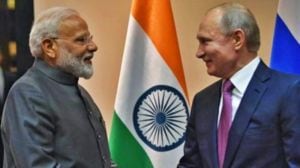Non-violence is the law of life
Ancient Indian political thought believed that the primary duty (dharma) of the king as a ruler was the happiness and prosperity of his peop...

Ancient Indian political thought believed that the primary duty (dharma) of the king as a ruler was the happiness and prosperity of his people. This was premised on the basis that peace and the rule of law would be the foundation on which these goals would be achieved. The last century, as we know so well, has been one of history’s most virulently violent periods. Yet the last century also demonstrated that great changes affecting human life and happiness could be achieved without adopting violent means. The Indian freedom struggle, for example, proved that the pursuit of the principle of non-violence could roll back the world’s sole super power without the bitterness and tragedies that accompany violent struggles…Mahatma Gandhi had said that while violence was a fact of life, non-violence remained the very law of life.
As we stand on the threshold of the 21st century we witness a great paradox: on one side, science has advanced tremendously to dramatically reduce disease, human suffering and ignorance; and, on the other side, science has also led to the building of weapons of mass destruction. The critical difference in how science would be applied in practice lies in the way we think about the goals, and the means and methods adopted to achieve them.
Democratic principle and practice is the core on which durable peace can be built. Empirical evidence has emerged in recent years to reconfirm the earlier belief that democracies do not go to war with each other. More important, democracy not only limits bilateral violence, but are also internally more peaceful. This is obviously so because decision makers in a democratic dispensation expect to be able to resolve conflicts by compromise, non-violence and peaceful methods, respecting the rights and continued existence of opponents. The more stable the democracy, the more will democratic norms govern its behaviour…
Unfortunately, not only has violence been the way of life, but also it has very often been legitimised even in civilised society. It is against this background that we have to see the phenomenon of terrorism which has come to rely on an explosive combination of extremist religious ideology in contradiction of the very essence of religion, transnational crime of various sorts ranging from narcotics trafficking to money laundering in a globalising environment of financial activity, information flows, and so on. The use of terror as a means of war across borders has even been raised to the level of legitimate use of force sanctioned by religion. Liberal democracies…are particularly vulnerable to this phenomenon not only because of the ease with which terrorists can operate in an open society but also because of the difficulties that democracies face in dealing with the phenomenon.
The world, therefore, stands at a defining point in human history. One road leads us back along violence and terror where force is simply met with force. The other beckons us along the non-violent path to peace, prosperity and happiness. The choice rests with us. The use of force must come as a last resort. But the focus must be on building a peaceful community and society..
(Excerpts from a special address at the 51st Pugwash International Conference, Agra, March 2002)
- 01
- 02
- 03
- 04
- 05































